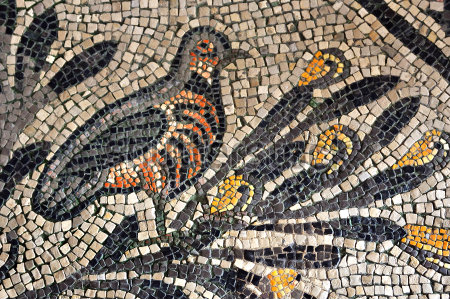Image source: Internet
Byzantine art is the name for the artistic products of the Eastern Roman (Byzantine) Empire, as well as the nations and states that inherited culturally from the empire. Though the empire itself emerged from Rome’s decline and lasted until the Fall of Constantinople in 1453, many Eastern Orthodox states in Eastern Europe, as well as to some degree the Muslim states of the eastern Mediterranean, preserved many aspects of the empire’s culture and art for centuries afterward.
A number of states contemporary with the Byzantine Empire were culturally influenced by it, without actually being part of it (the “Byzantine commonwealth”). These included Bulgaria, Serbia, and the Russia which had close ties to the Byzantine Empire despite being in other respects part of western European culture. Art produced by Eastern Orthodox Christians living in the Ottoman Empire is often called “post-Byzantine.” Certain artistic traditions that originated in the Byzantine Empire, particularly in regard to icon painting and church architecture, are maintained in Greece, Serbia, Bulgaria, Macedonia, Russia and other Eastern Orthodox countries to the present day.
The splendor of Byzantine art was always in the mind of early medieval Western artists and patrons, and many of the most important movements in the period were conscious attempts to produce art fit to stand next to both classical Roman and contemporary Byzantine art. This was especially the case for the imperial Carolingian art and Ottonian art. Luxury products from the Empire were highly valued, and reached for example the royal Anglo-Saxon Sutton Hoo burial in Suffolk of the 620s, which contains several pieces of silver. Byzantine silks were especially valued and large quantities were distributed as diplomatic gifts from Constantinople. There are records of Byzantine artists working in the West, especially during the period of iconoclasm, and some works, like the frescos at Castelseprio and miniatures in the Vienna Coronation Gospels, seem to have been produced by such figures.
In particular, teams of mosaic artists were despatched as diplomatic gestures by emperors to Italy, where they often trained locals to continue their work in a style heavily influenced by Byzantium. Venice and Norman Sicily were particular centers of Byzantine influence. The earliest surviving panel paintings in the West were in a style heavily influenced by contemporary Byzantine icons, until a distinctive Western style began to develop in Italy in the Trecento; the traditional and still influential narrative of Vasari and others has the story of Western painting begin as a breakaway by Cimabue and then Giotto from the shackles of the Byzantine tradition. In general Byzantine artistic influence on Europe was in steep decline by the 14th century if not earlier, despite the continued importance of migrated Byzantine scholars in the Renaissance in other areas.
Islamic art began with artists and craftsmen mostly trained in Byzantine styles, and though figurative content was greatly reduced, Byzantine decorative styles remained a great influence on Islamic art, and Byzantine artists continued to be imported for important works for some time, especially for mosaics.
The Byzantine era properly defined came to an end with the fall of Constantinople to the Ottoman Turks in 1453, but by this time the Byzantine cultural heritage had been widely diffused, carried by the spread of Orthodox Christianity, to Bulgaria, Serbia, Romania and, most importantly, to Russia, which became the center of the Orthodox world following the Ottoman conquest of the Balkans.
The Ottoman Empire, also historically referred to as the Turkish Empire or Turkey, was a Sunni Islamic state founded by Oghuz Turks under Osman I in northwestern Anatolia in 1299. With conquests in the Balkans by Murad I between 1362 and 1389, and the conquest of Constantinople by Mehmed II in 1453, the Ottoman sultanate was transformed into an empire.
During the 16th and 17th centuries, in particular at the height of its power under the reign of Suleiman the Magnificent, the Ottoman Empire was a powerful multinational, multilingual empire controlling much of Southeast Europe, Western Asia, the Caucasus, North Africa, and the Horn of Africa. At the beginning of the 17th century the empire contained 32 provinces and numerous vassal states. Some of these were later absorbed into the empire, while others were granted various types of autonomy during the course of centuries.
With Constantinople as its capital and control of lands around the Mediterranean basin, the Ottoman Empire was at the center of interactions between the Eastern and Western worlds for six centuries. Following a long period of military setbacks against European powers and gradual decline, the empire collapsed and was dissolved in the aftermath of World War I, leading to the emergence of the new state of Turkey in the Ottoman Anatolian heartland, as well as the creation of modern Balkan and Middle Eastern states.
Constantinople was the capital city of the Roman and Byzantine, the Latin, and the Ottoman empires. Following the Muslim conquest, the former bastion of Christianity in the east, Constantinople, was turned into the Islamic capital of the Ottoman Empire, under which it prospered and flourished again. After the founding of the modern Republic of Turkey —the successor state of the Ottoman Empire— the city was renamed Istanbul in 1923.
公元330年,罗马皇帝君士坦丁一世在拜占庭建立新都,改称君士坦丁堡(Constantinople),别名新羅馬。宏伟壮观的君士坦丁堡,占地为罗马的10倍,在公元12世纪时,君士坦丁堡是全欧洲规模最大且最为繁华的城市。
君士坦丁堡在1204年的第四次十字军东征中被占领,成为拉丁帝国的首都,1261年由迈克尔八世帕拉奥洛古斯率领尼西亚帝国军队收复,成为重建的东罗马帝国首都。后来拜占庭帝国逐渐衰落,领土范围也缩减到君士坦丁堡及其周边地区。公元1453年,君士坦丁堡再次被奥斯曼帝国攻陷,并成为奥斯曼帝国的新都。从拜占庭王国到古罗马帝国的君士坦丁堡再到奥斯曼帝国的伊斯坦布尔,这座城市承载了太多荣耀与悲伤,历史学家们习惯上将基督教统治下(330年至1453年)的该城称作君士坦丁堡,而将此后伊斯兰教统治下的城市称作伊斯坦布尔。君士坦丁堡作为庄重典雅的基督教圣地,让人无限神往。可惜于15世纪被奥斯曼帝国攻陷,被崇尚简单质朴的穆斯林彻底伊斯兰化。圣索菲亚大教堂也成为了清真寺,见证了延续千年的东罗马帝国的兴衰。拜占庭的荣耀及东正教的衣钵后来在俄国得到了传承,如今俄罗斯的国徽依然是拜占庭帝国的双头鹰。
君士坦丁堡(伊斯坦布尔)还保存着为数众多的艺术作品。在被奥斯曼帝国攻克之时,该城已经逐渐破败,但在此后得到了迅速的复兴与发展,并于17世纪中叶再次成为当时世界第一大城市。
奥斯曼土耳其帝国兴于十三世纪末(1299年),灭于二十世纪初(1922年),领地横跨欧亚非三大陆,时间纵跃六个世纪,文化上承袭了双重文明(西方的拜占庭文化和东方的伊斯兰文化)。在15世纪至19世纪中,它实际上是唯一能挑战欧洲诸强的伊斯兰势力。人类进入二十世纪后不久便爆发了第一次世界大战,这场战争不仅造成全球大范围内生灵涂炭哀鸿遍野,也直接导致了德意志、俄罗斯、奥匈和奥斯曼等四大帝国的分崩离析。

